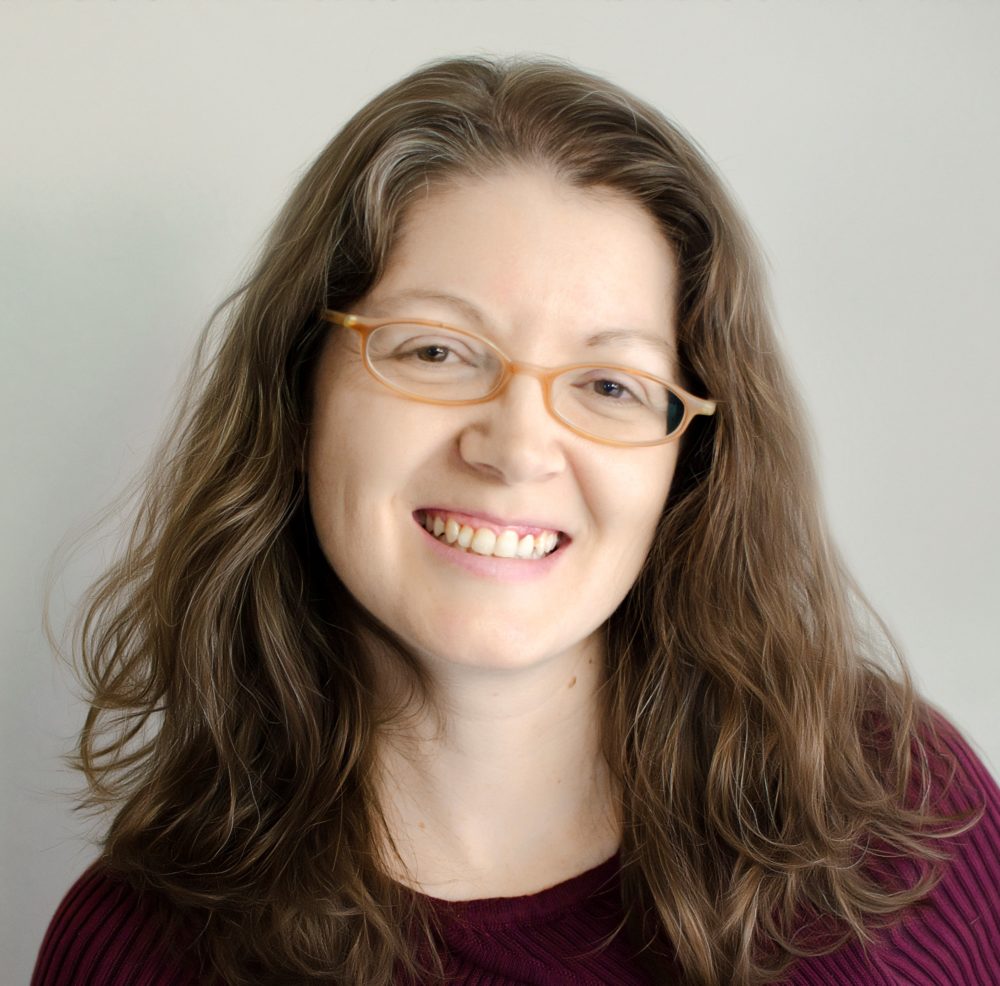These days, every company knows the buzzwords: diversity and inclusion. But today’s talent pool is looking for more than words in a PR statement. According to author Dan Schawbel, in 2021, 70% of job seekers said they want to work for a company that demonstrates a commitment to diversity and inclusion. This requires effort from your entire organization, and Handshake VP, Employer Partnerships Jessica Peluso outlines some changes that you can make to your brand, and your application, interview, and offer process that will help find the talent you are trying to attract and hire.
Below is the transcript of Jessica’s session. You can see all of Jessica’s slides here.
Hi everyone. And thank you so much for coming to this session on such a beautiful day, late in the afternoon. I really appreciate you coming to talk about how to attract, hire, and build a more diverse sales team in your organization. For anyone who hasn’t heard of Handshake, we believe that we can help every student and alumni find a great job and build a meaningful career, without any experience, no connections and no luck required. We know that talent is evenly distributed across the US, but opportunity is not. And so at Handshake, we want to make sure that no matter what someone’s race, ethnicity, or socioeconomic status is, that they’re able to find meaningful employment and Handshake can help support that at scale. So before I get started, I wanted to talk about something that one of my AEs said in a team meeting, while I was preparing for this presentation. He opened up to the team and he said, “I came to Handshake because I want to teach employers that people are great, not despite their uniqueness and differences, but because of it.”
And it was such an impactful statement at that time. And we were all kind of quiet for a minute and it was like, “Wow, that’s what we do at Handshake. We make impact every single day, we go out there and we help employers know how they can be better.” And so as we start to talk through this today, I hope that resonates with you as much as it did with me. And that as you leave this today, you’ll have a new passion for helping find diverse talent, bring them into your organization, and making sure that we’re all looking to make that change.
So I’ve been building top-producing sales teams for a really, really long time. It’s challenging, but it’s one of my favorite parts of my job. And it’s something that’s so important. When I look at these pictures, I think about all the success that I’ve had over the years and all of that success has come from the people that are a part of my teams. And in most cases, not just one team, in most cases, they’ve been on multiple teams or they’ve followed me from company to company. And I think I talk to people all the time about how to build a top producing sales team and people say, “Just go out and hire a bunch of top producers.” It seems like it shouldn’t be that hard, right? But it really is difficult. For all of you who are doing it, you know how difficult it is to build that team. So today I’m going to talk about, not just diversity, but how to attract hire, and build a top producing team, because I believe that the secret behind that is through diversity.
So over the years, I’ve watched many sales leaders go out and say, “Brian’s my top producer. I’m going to go out and hire 25 people that are just like Brian.” And essentially what they do is they hire the same profile person over and over and over. And what starts to happen is that the people within that group can’t learn and grow from each other because they’re all good at the same thing and they’re all bad at the same thing. So what starts to happen is that instead of helping each other, they start to compete with each other because that’s all they’re able to do. This is when you end up with one of those highly competitive environments that no one wants to work in, it’s not collaborative, and it’s just quite frankly not fun.
So when you start focusing on hiring people who are different, things like different backgrounds, different tenures, different locations, different race, different ethnicity, this is when you’re going to find a group of people who are all good at something different, and they’re all bad at something different. And when you bring that group of people together, it creates a culture of growth and you start to have a growth mindset within your organization. People know when they have a question or they need help with something, who the right person on the team to go to is to learn that. It helps you up-level your team with every single person that you add and you can create that as you continue to add more types of diversity throughout your sales organization.
So, over my career, I have learned a lot. I’ve certainly made a lot of mistakes in my time, but one of the most important lessons I’ve learned has been around truly embracing people’s differences and understanding that there are so many ways to be diverse. I think when we hear the word diversity, many times, we immediately think about internal characteristics that you’re born with like gender, race, ethnicity, and age, but there are so many other ways to be diverse. Think about characteristics you weren’t born with and things that can change over the course of your life. So some of those are socioeconomic status, religious beliefs, education, even your location can change that.
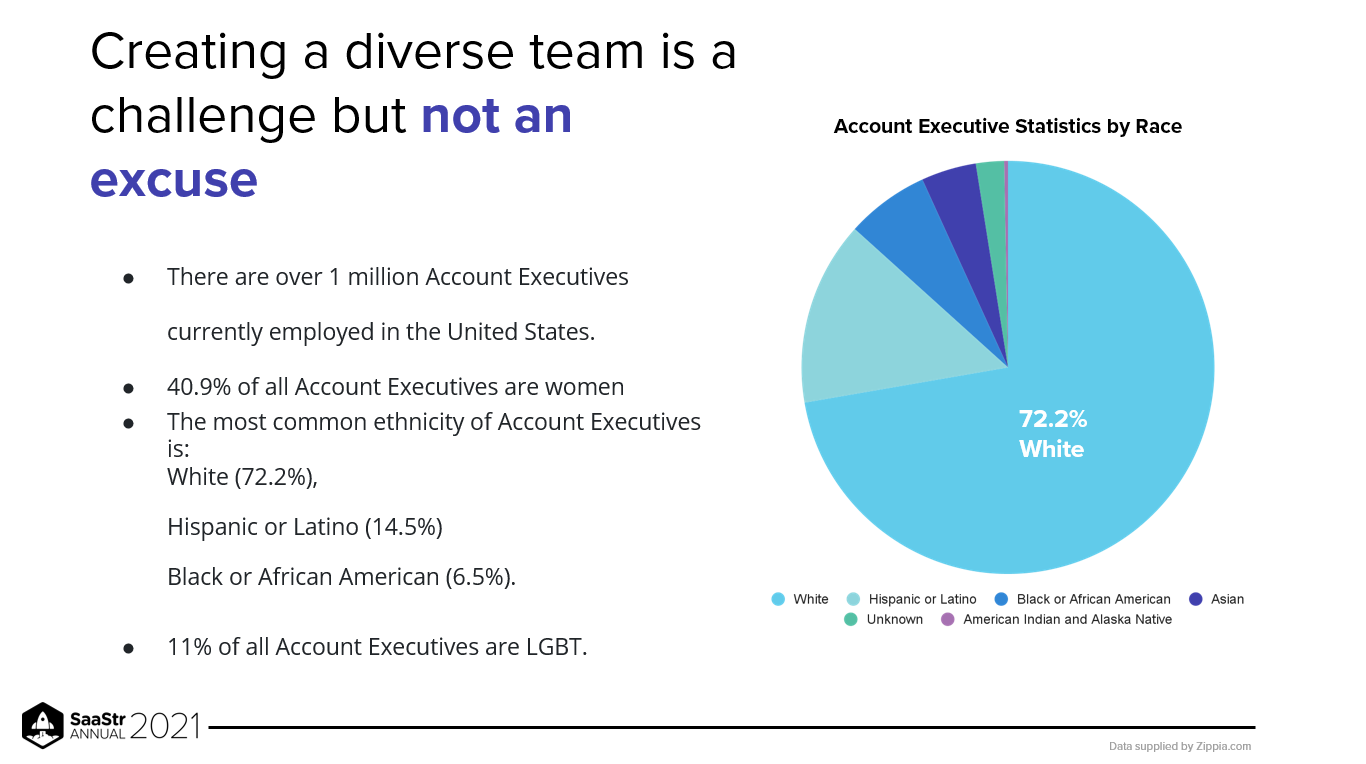
So each of these experiences, as you go through life will change your experience and who you are. It’s important that as leaders, as we build teams, that we recognize those different experiences and embrace them. If you want to truly be successful, you will need to embrace all kinds of diverse talent within your sales org or any organization that you’re building today. And then you’ll have to make sure that environment is equitable and inclusive to support them in an ongoing manner. So we’re going to touch on all of that today.
So I’m going to talk a little bit about the progress we’ve been able to make it Handshake since I joined in January 2020. You can see here that when I started, we had nine Enterprise AEs on the team and most of them were white males. Most of them lived in San Francisco. They’re about the same age, about the same tenure. Kelly was so excited when I started at Handshake just to have another female in the room. And I can’t tell you how common that is on enterprise teams. So, fast forward a year later, we had grown the team to 14 enter enterprise AEs. And we were able to actually equalize the balance of men and women on an enterprise team. For those of you who aren’t in enterprise sales, this is highly unusual in this environment. And we were also able to add some race and ethnicity to the group as well.
So, fast forward six months, this is where we were at the beginning of September. You can see here that now we have more women than men on the team, something I’m very proud of. We’ve been able to add ethnicity and race, but so many other things as well. We’ve been able to add people from different locations across the country, different tenures, different ages, different educations, different experiences. And this is what truly represents a diverse team. When I joined, we had plans to only hire in San Francisco, New York, and Chicago. And now more than a third of our group is dispersed across the country. I’m going to go over some actual stats on the next few slides, but overall, I’m really proud of the progress that we’ve made at Handshake and we still have some room to grow. So we’re building the team out to 34.
So I have seven more hires that will continue to be really intentional about the way that we are looking and sourcing and talking to people about these opportunities to make sure that every time we bring an Enterprise AE on, they’re bringing a skill to the team that we know is going to up-level and help the team grow and learn from each other. So over the next few slides, I’m actually going to shift from talking about the overarching term of diversity, to focusing on underrepresented groups, which we call URGs, which talks more about how they identify. So a lot of times we look at a slide like this, and we think we know how someone identifies, but you really can’t have that perspective, especially as you’re looking to add people to your team. It’s something that you need to be very clear about, very intentional about, and work with your HR teams to make sure that you understand the true self-identification as you work to improve these numbers.
So, as I mentioned earlier, 56% of the team is female. For most of my early career, I was the only woman in the room, the only woman in meetings, the only woman on the sales floor, and I really didn’t feel like I had a voice. It took me a lot of years before I really found that I was comfortable in meetings and able to speak out. I was lucky enough that I found men along the way, who believed in me and mentored me and sponsored me, but I never had a strong woman sales leader at any of my roles. When I look at this graph on the right, and I see the progress that I’ve made with the enterprise team, I like to think that I’m changing that type of sales environment and making sure that everyone in the room feels like they have a voice.
So, it’s not easy to be a white woman standing on stage talking about racial representation. It’s a conversation that so many of us are uncomfortable having, but we have to start being comfortable talking about this topic. When I was going through and prepping for this, I met with one of the leaders of our Wakanda Group who supports black individuals at Handshake and she was like, “Absolutely, you have to go out there and talk about this. This is the problem, that we don’t have these conversations and that we’re not being more transparent and talking about this across our organizations.” So when I started on this journey, we went on a mission to exceed the US census data. We thought that is a great place to start. I talk to employers every day and that’s what many of them are working to achieve. So right now we still have a little ways to go.
But with our seven hires and the pipeline that we have through the end of the month, I believe we’ll be able to exceed that by the end of October. But when you look at this and you think about racial representation, you’ll see that all non-white people are lumped into one group. That’s really not the way we should be talking about this. There’s so many types of people when we start talking about people of color and we need to start representing this and making sure that they all have their own piece of the pie and that they all have their own voice in the room. Getting to the point that we’re at today was a lot of progress, but I’m still learning, my whole company’s still learning, and I hope you’re all still learning about these things and trying to be better. That’s a big part of why I’m here today.
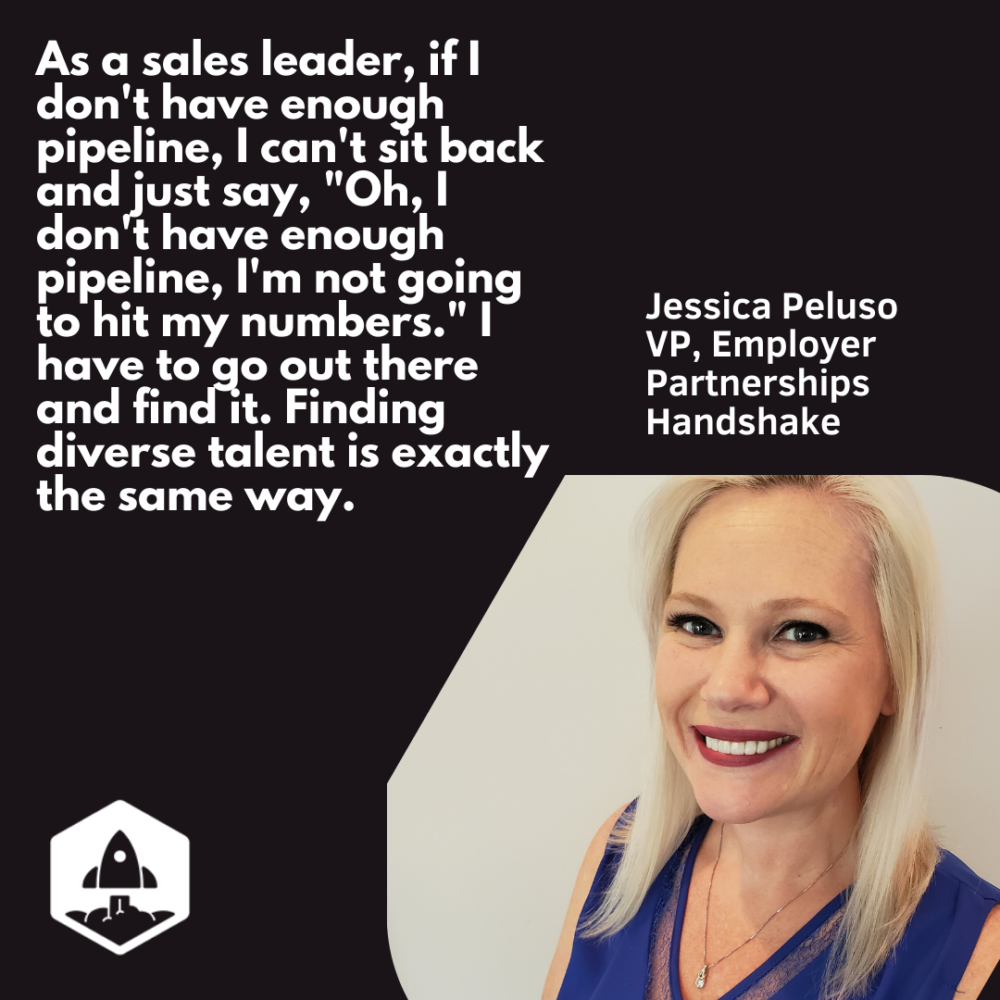
If I can help any one of you go back and make an impact in your company, then this was worth it, standing up here after being in the house for a year and a half and coming and standing in front of a large group of people. But I’ve committed to my team and my organization, but this is only the beginning. Like we set the bar and then we achieve the bar and then we set a new bar and that process just has to continue over and over again. If any of my Peloton family is out there, this will sound really familiar, but it’s about progress, not perfection. It’s about continuing to learn and grow, being really transparent about where we have opportunity and then continuing to grow from there.
So I’m not going to stand up here and tell you that this is going to be easy. Finding diverse talent is a challenge because of the numbers that you see here on the screen. But it’s possible, and we can’t use it as an excuse to not make change or to hide behind. For most of you in this room, you’re leaders, where you come over challenges every single day. As a sales leader, if I don’t have enough pipeline, I can’t sit back and just say, “Oh, I don’t have enough pipeline, I’m not going to hit my numbers.” I have to go out there and find it. Finding diverse talent is exactly the same way.
I’m responsible for it, you’re responsible for it, your sales team is responsible for it, your C-suite is responsible for it, your CEO is responsible for it. Everyone has to start working together in order to make this change. We all know that hiring a sales team is going to be challenging because of the demographics that you see on this screen, but it is critically important that we start to put focus in this area and start to put numbers behind it. So I’m going to walk through some slides on why this is so important. Back in January, Deloitte did a survey of CEOs and then 94% agreed that DEI was a personal strategic priority and 90% agreed that they wanted to be a leader in the space. I mean, just think about those statistics. They’re crazy, right? That’s everyone. But you’ll see here that they talk about diversity, equity, and inclusion.
I want to point out because I only have half an hour today, and I’m mostly speaking about the diversity aspect, but equity and inclusion are so important to think about as well. As you start working through this, you’ll start to hear terms like, “Allyship, mentorship, sponsorship.” These things are all really important that you begin to educate yourself and make sure that you’re including them in your strategy. You can also see that 72% of CEOs plan to disclose their DEI metrics to the public. This is great news because if you’re making an impact and making the change, candidates will come to work for your organization because they see that you care.
Here’s where it starts to become really important. Earlier this year, Dan Schwabel found that 70% of employees said that they want to work for a company that demonstrates diversity and inclusion. They’re not asking for it; they’re demanding it. We’re in one of the most competitive hiring markets that has ever happened. And if you’re not willing to invest in the things that your employees want, they’re going to start going to work for employers who are.
If that’s not enough and in addition to making your CEO happy, and your employees happy, you want to look at the financial aspect, data shows that if you are diversified ethnically, your financial performance will go up by 35%. And if you’re diversified by gender, it’ll go up by 15%. So I don’t think there’s anybody in this audience that doesn’t want their financial performance to increase by a percent. McKinsey also suggests in this study that other kinds of diversity like age, sexual orientation, and experiences are likely to bring another level of competitive advantage for companies that continue to invest and attract top talent.
So this is one that I’m obviously really passionate about, something that I talk about every single day. Gen Z is here, and most people don’t realize that. They’re entering adulthood as the first and most radically different group of people. They’re racially different, they’re ethnically different, and they’re on their way to becoming the best-educated generation yet. They turn 23 this year. And so they are going to be entering the job market in full force. And as the most diverse generation to date, they are demanding that employers are investing in this area and they want to go to work for companies where the teams feel like them and look like them and where they know that they’re going to feel included. So if you haven’t begun to think about how you’re going to attract, hire, and retain Generation Z, now is the time. So I hope by now, this is something that you’re thinking, “Okay, I should go back and make a change. I should start doing something to change this in my organization, but where do I start?”
The first place is to set achievable and transparent goals within your sales organization. So this is something that a lot of people skip and they just start by working on brand or talking to the recruiters about how they’re going to source, but really start and be very prescriptive about where you’re trying to get to. If you only have one or two headcount to add to your team this year, it’s going to be really hard to make significant improvement in this area. And those one or two hires become critically important in making the change. Once you’ve committed to something, make sure you lay out how much time it’s going to take and what you’re going to need to get there. Transparency through your organization in this area about how and when you’re going to be able to achieve specific goals is really important.
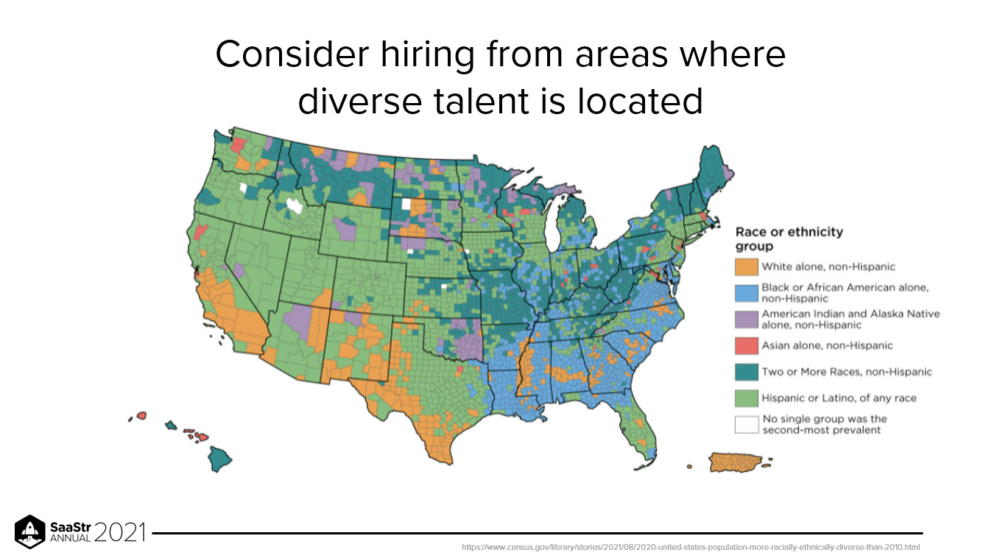
The employers that I speak with every day, who are successful in this area, are successful because they’ve gained buy-in from their C-suite and they have the full support for them as they go through and start to make change in their organization. Another thing that can really help is connecting with your ERG or Employee Resource Group leaders. They can help give you a different perspective and help you talk about how you’re performing today and making sure that they’re supporting you in what you hope to accomplish in the upcoming years. And if you want to get started with Mellody [Hobson] here, just Google her. She has amazing content out there that can help you get started.
Okay, so we’ve talked about setting your goals and now you’re going to go and start to achieve them. So how do you attract talent? This is the very first step, and it’s so important. You have to work on your brand. And when you think about your brand, that means you, your website, your recruiters, any content that’s out there, your team, your interview process, anything that would come in touch with a candidate from the time they start researching your company until the time that they would move to getting an offer. But here’s where a lot of companies fall short. They go out and they update their website and they update their social media and then they wait. And that’s not going to do it for you. It might help a little bit, but at the end of the day, you’re still not changing. So the things that you need to do in your organization are a lot, very detailed.
We’ve written a blog, I have it posted on my LinkedIn page if you want to see it in more detail, but essentially you want to make sure that everyone in your team is helping. Everyone should be a brand ambassador and onboard with the process. You want to make sure that you embrace personalization. So this is a big one. You can’t send the same messaging to, I don’t know, a black female in San Francisco, as you would to an Asian male in Atlanta. You just want to make sure you change it so it really resonates with them. And for you, if you’re in a sales role, it sounds a lot like prospecting, right? Writing cadences and templates, this is what we do for a living. Recruiting is a lot like sales. So you need to start changing what you’re doing today to align with that. And then you need to be thinking about consistency throughout your process to ensure that everyone has an equitable experience.
And this is something I will talk about a little bit more in the next few slides, but at the end of the day, elevate their candidate experience. You want someone to come in and feel like they’re going to be included in your organization. You want to make sure that every interaction you have with them counts. This is your opportunity to tell your story, this is your opportunity to shine. So make sure that you’re focused on what that experience is like. And the last thing is that if you are going to lean on your ERG leaders or other employees in your organization, make sure you’re compensating them for going over and above. At Handshake, we’ve recently started compensating our ERG leaders because they are putting in a lot of time and effort to make sure that they’re helping us build our culture and just making the company better in general.
So, let’s talk about once your brand is elevated and you’re now you’re going out there and you’re saying, “How can I source for market candidates?” You have to start thinking bigger and thinking about pools of candidates that you’re not accessing today. Gen Z is a great place to start. As I mentioned earlier, third of the global population, you can see that one in four are Hispanic and nearly half are racial or ethnic minorities. So if you’re not thinking about early talent today, this is an immediate place that you can add representation into your hiring pipeline. Consider hiring from areas that you haven’t before. In the last 18 months, the world has changed drastically, especially when hiring Enterprise and Strat AEs.
You can start to look at where the talent that you are looking for is located. It’s amazing how much representation changes state by state, even county by county, so educate yourself on where the candidates are that you’re trying to find. It can also help or hurt your efforts to hire from underrepresented groups. So if you are looking for a black candidate in San Francisco, you can see here, it’s only 5% of the population. But if you move that search to New York City, now you’re at 24%. And then if you go to Atlanta, it more than doubles, but if you’re looking for an Asian candidate, then Atlanta’s not such a great place to be sourcing. You’d be much better off looking at San Francisco.
Okay. So we’ve talked about some ideas of how to find new talent in different areas, across different types of pools. And now we’re going to talk a bit about the hiring process. So you absolutely are going to need to do training on removing hiring bias from your hiring process. It’s not just for your recruiters. A lot of people think, “Oh, we’ll have the recruiters go through this process and that’s going to fix it.” Everyone needs to go through this process. You cannot overcome hiring bias or remove it from your process, if you don’t know it exists. Unconscious racism, ageism, and sexism play a big role in who we hire. Francesca Gino, a Professor at the Harvard Business School, says that, “Hiring bias is something that causes us to make decisions in favor of one person or a group to the detriment of others.” This is going to hinder the diverse environment that you need to build in your organization if you want to be successful. So when we align ourselves in images and things that we see, we start to have this hiring bias.
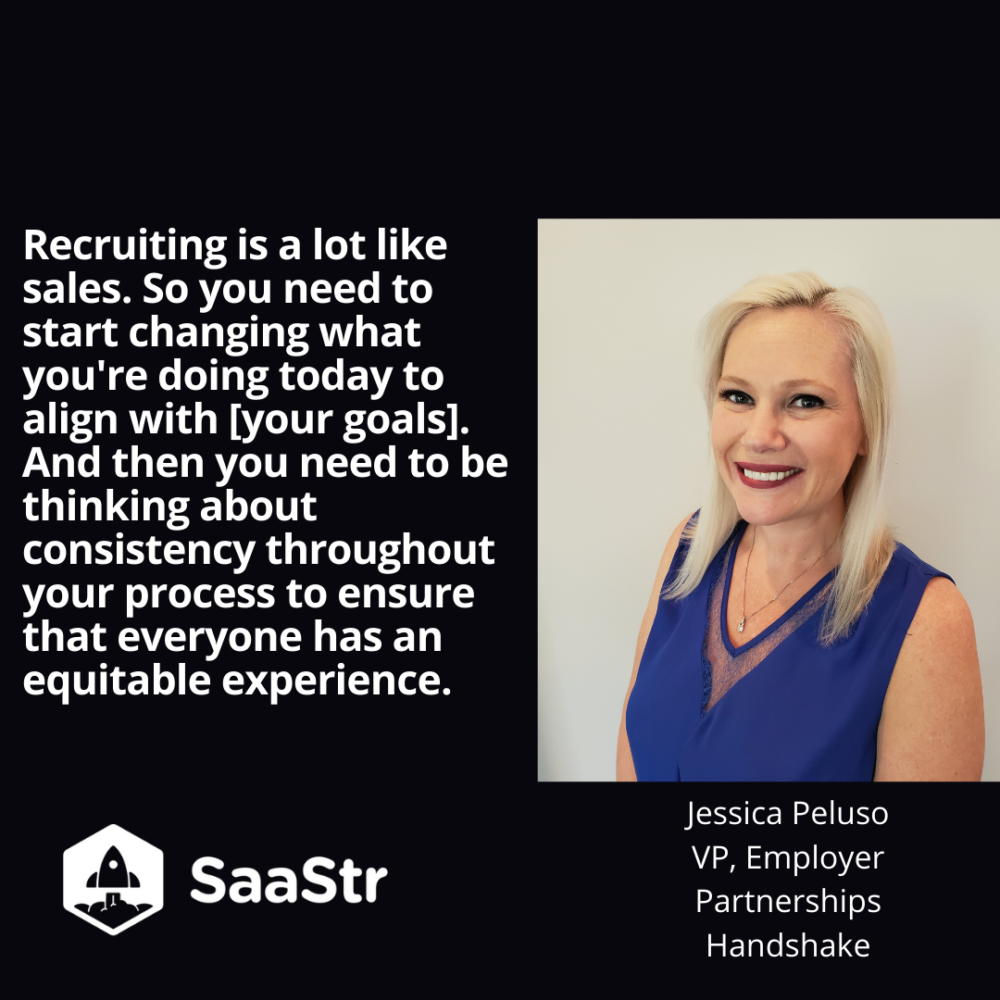
So if you think about seeing women with careers in nursing and education and men with roles in C-suites, if you’re interviewing for those roles, that can start to change the perception of who’s sitting across the table from you or on a Zoom link today. Iris Bonnet, the author of What Works: Gender Equality by Design, talks about how seeing is believing. So basically, if we don’t see male kindergarten teachers or we don’t see female engineers, then we don’t see how that person could fit into the role. And we may actually change the questions for the process that we normally go through.
So you can mitigate bias as a hiring manager and there are some really basic steps that you can put in place. You want to start by documenting everything, and really aligning the team. You want to be very clear and explicit about the candidates that you’re looking for and make sure everyone in the hiring process understands the part that they’re going to play as they go through this. So, at Handshake, we actually create a role playbook. It includes the job description, a detailed competencies that we’re looking for. We then write questions out for each interviewer that tie back to those competencies. And we even create a scorecard of what good and bad looks like as they go through the interview process. Then before the role even gets posted online, we have a sync. Everyone that’s going to touch this candidate from beginning to end: sourcing, interviewing whatever it is, they come to that meeting and we make sure that everyone’s aligned so we know what good looks like and what bad looks like.
And then every single week we sync on the candidates that have come through the pipeline and we talk about what was good and what was bad, and maybe how we can change that as we go through the next iteration. So if you can be deliberate and consistent in your process, it creates constant transparency. So it’s very difficult for hiring bias to creep in. I can’t say enough how important structured interviewing is and I’m sure most of you in this room have been exposed to at this point, but it’s something that hiring managers generally struggle with in real life. When I do an interview, every single candidate gets asked the same questions every single time I conduct an interview. And it’s really important in making sure that they have a fair and equitable interview process.
It’s very common for people who, as they’re talking to someone, if you really connect and you like each other, you’re going to ask much more casual questions because you like them. You’re comfortable with them, that’s natural for you. And when you have someone that doesn’t have that same interaction, a lot of times you’ll start to ask more challenging questions or different questions than you would’ve asked another candidate, and that’s not fair to the people interviewing for the role. So it’s important that you put the structure in place and make it easy for your hiring managers to ensure that they’re asking the same consistent questions at every single interview.
So along that same line, you should be thinking about the people and what their experience is going to be as they come through the interview process. So when I put someone through to a panel interview, it’s because I believe that they’re a good fit for Handshake and that they’re excited about the opportunity. I want that person to see themselves on my team. I want them to feel like as they go through the interview process, “This is a team that I want to work for.” If you have structured interviewing in place, it’s very easy to swap the people out because they’re all going to ask the same questions and fill out the same scorecard. This allows you to make a more customized experience for your candidates as they go through the interview process. It ties back a lot to brand. The people that you put in front of this candidate and the interview process are part of your brand so it’s important that you continue to think of that.
So we’re coming up on time, and this is my last slide, but it’s something that I am really passionate about. We’ve spoken about how to attract and hire diverse talent, but there is one more option. You can build it from scratch from the start, and you can do that with SDRs. So your SDRs can be a really powerful place to add diversity on your team. We spoke earlier about that Gen Z audience entering the workforce, so this is a great place to include them in a long-term strategy. If you invest in bringing people in their first or second role out of school, you can train them exactly the way you want. No bad habits, and then you build a true farm system within your sales organization. This will not only give you more pipe generation from having SDRs in seat, but it means you’ll always be able to promote internally from a bench of people who already know your product, your systems, and are looking for that next step in their career.
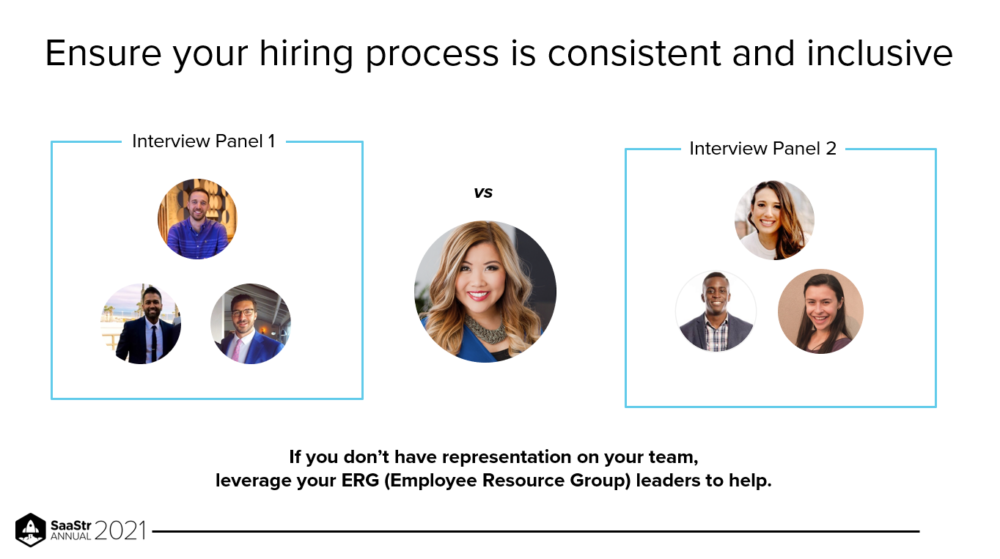
One thing that’s critically important is that you have to build a solid onboarding and continuous education program, if you’re going to invest in this strategy in really building out your SDR team. But it will give you the opportunity to hire from a much more representative group of people and truly set yourself up for long term success. So I’ve highlighted the key takeaways here, but I think what I’d really like to do is go back to the quote from Mohammed, my AE at the beginning of the session, “We teach employers every single day that people are great not despite their uniqueness or their differences, but because of them.”
I hope that as you go back to your companies, you’ll make a commitment to yourselves, to your teams, to your organizations, to make diversity, equity, and inclusion, a top priority, not just in your sales organization, but in your entire organization. If we all begin to commit to making these changes and building more diverse teams, we’re going to be more successful at the end of the day.

